МИНИСТЕРСТВО ОБРАЗОВАНИЯ ИРКУТСКОЙ ОБЛАСТИ
ГОСУДАРСТВЕННОЕ БЮДЖЕТНОЕ ПРОФЕССИОНАЛЬНОЕ ОБРАЗОВАТЕЛЬНОЕ УЧРЕЖДЕНИЕ ИРКУТСКОЙ ОБЛАСТИ
«БОДАЙБИНСКИЙ ГОРНЫЙ ТЕХНИКУМ»
Методическая разработка
открытого урока
Тема: «Изобретения и изобретатели»
Курс, группа: II курс, МД-14
г. Бодайбо
2016 г.
Методическая разработка открытого урока по теме «Изобретения и изобретатели», предназначена для реализации процесса обучения в учреждениях СПО.
Организация-разработчик: ГБПОУ ИО«Бодайбинский горный техникум»
Разработчик: преподаватель А.М. Агеева
Рассмотрена, утверждена и рекомендована к применению на заседании методического Совета ГБПОУ ИО «Бодайбинский горный техникум»
Протокол №_____ от «___»__________2016 г.
Методист техникума: Высотина О.А.
666901, Иркутская область,
Бодайбинский район,
Г.Бодайбо, ул.Железнодорожная,1,
«Бодайбинский горный техникум»
Тел. (39561) 5-63-75, 74-5-07
[email protected]
Тема: «Изобретения и изобретатели».
Тип занятия: обобщение изученного лексического и грамматического материала.
Применяемые технологии:
Компьютерные (информационные) технологии
Здоровьсберегающая технология
Цель занятия: Активизация тематической лексики в устной речи обучающихся в диалогической и монологической формах в процессе развития иноязычной коммуникативной компетенции студентов.
Задачи занятия:
Образовательные:
активизировать употребление лексики по теме «Изобретения, которые потрясли мир»;
Практиковать учащихся в устной речи;
Совершенствование слухо-произносительных навыков, в том числе применительно к новому языковому материалу.
Развивающие:
развитие творческих способностей обучающихся, образного мышления, памяти;
развитие умений участвовать в беседе на знакомую тему, осуществлять запрос информации, выражать свое отношение к высказыванию партнера, свое мнение;
развитие умений делать сообщения, содержащие наиболее важную информацию по теме, рассуждать о фактах, приводя примеры и высказывая свое мнение, а также развитие умения строить предположения относительно хронологии предложенных изобретений;
развитие информационной (готовность к работе с информационными источниками) и образовательной (готовность к самообразованию, в т.ч. способность к получению знаний из различных источников) компетентности обучающихся.
Воспитательные:
формирование коммуникативных умений, умений саморегуляции и саморегулирования своей учебной деятельности;
формирование социальной (готовность к взаимодействию, освоению новых способов деятельности, умение работать в команде) и коммуникативной (готовность и способность осуществлять устную и письменную коммуникации) компетентности.
Сопутствующая задача – развитие умения читать с детальным пониманием содержания и с целью извлечения конкретной информации, развитие умения работать в парах.
Формы и методы: групповая, парная, индивидуальная;
- репродуктивный, продуктивный, наглядно–иллюстративный, частично- поисковый.
Оборудование: компьютер, мультимедийный проектор, экран, аудиозапись, видеозапись, компьютерная презентация по теме «Изобретения и изобретатели», словарь учащегося, тематические картинки, раздаточный материал.
Межпредметные связи: английский язык, информационные технологии, физика, русский язык, история.
Овладение обучающимися общими компетенциями (ОК):
ОК 2.Организовывать собственную деятельность, исходя из цели и способов ее достижения, определенных руководителем.
ОК 3. Принимать решения в стандартных и нестандартных ситуациях и нести за них ответственность.
ОК 4. Осуществлять поиск и использование информации, необходимой для эффективного выполнения профессиональных задач, профессионального и личностного развития.
ОК 5. Использовать информационно-коммуникационные технологии в профессиональной деятельности.
ОК 6. Работать в коллективе и команде, эффективно общаться с коллегами, руководством, потребителями.
ОК 7. Брать на себя ответственность за работу членов команды (подчиненных), результат выполнения заданий.
ОК 8.Самостоятельно определять задачи профессионального и личностного развития, заниматься самообразованием, осознанно планировать повышение квалификации.
ОК 9. Ориентироваться в условиях частной смены технологий в профессиональной деятельности.
Учебно-методическое обеспечение:
1. Карпова Т.А. Английский для колледжей. Учебное пособие. М.: Издательско-торговая корпорация «Дашков и К», 2013. 320 с.
2. Кузовлев В.П. Английский язык: учебник для 10-11 кл. общеобразовательных учреждений. М.: Просвещение, 2012. 351 с.
3. Полякова Т.Ю. Английский язык для инженеров. Учебник. М.: Высшая школа, 2010. 463 с.
Интернет-ресурсы:
Wikipedia
festival.1september.ru (информация по грамматике анг.языка)
www.zavuch.ru (схема открытого урока)
pedsovet.org (оформление метод. разработки)
engblog.ru (информация по фонетическим упражнениям)
nsportal.ru (информация по диалогической речи)
lingvana.ru (тексты для аудирования)
englishhobby.ru (цитаты и афоризмы о науке)
План занятия:
Временная реализация: 1 час 30 минут
I Организационный момент. (5мин.)
1. Приветствие. (Слайд 1)
2. Определение темы и целей работы на уроке. (Слайды 2-4)
II Основная часть урока. (80 мин.)
1. Работа с лексическим материалом. (7 минут)
Фонетическая зарядка. (Слайды 5-7)
(отработка произношения лексики по теме)
2. Актуализация опорных знаний, их коррекция:
а) тренировочные вопросно-ответные упражнения;
речевая зарядка (дать аргументы за и против) (Слайды 8-9)(8минут)
б) Чтение и перевод предложений об изобретателях и их изобретениях (Слайды 10-27) (14 минут)
Аудирование текста “Inventions»
со зрительной опорой (Cлайды 28-30) (2 минуты)
Выполнение заданий к тексту:
а) письменная работа с опорой на текст (Слайд 31)(5 минут)
б) работа в парах ( выполнение дифференцированных заданий)(5 минут)
5. Физпауза. Прослушивание песни «Изобретения и их изобретатели» в видеоролике; выполнение упражнения на понимание прослушанного. (Слайд 32) (5минут)
6. Ролевая игра «Встреча с знаменитым изобретателем» (групповая работа) (Слайд 33) (10 минут)
7. Беседа о российских изобретателях:
а) Монологическое высказывание (доклады о российских изобретателях)(14 минут)
б) Диалогическая речь (обсуждение прослушанных сообщений) (Слайды 34-36)(8 минут)
III Заключительный этап. (7мин.)
1. Домашнее задание. (Слайд 37)
2. Подведение итогов урока, выставление оценок. (Слайд 38)
Ход занятия
I Organization of the lesson. Aims. (5min.)
Teacher: Good afternoon, dear students! I’m very glad to see you.
How are you today? (Fine, thanks)
We have got some guests. Say “Good afternoon” to them. Well done!
Sit down, please. Let’s start our lesson. (Слайд 1)
T: I would like you to look at the board, at your desks and look around.
Try to guess: What are we going to do at the lesson?
Student 1: We’ll speak about the inventions.
Student 2: We’ll speak about the inventors.
T: Sure, We’ll speak about the inventions that shook the world.
We live in unusual time. Now is 2016. It’s the beginning of the XXIst century and the 3rd millennium. We don’t know what we’ll have in a future, but I hope it will be beautiful and interesting. They say we can’t have a great future if we don’t realize the past.
T: So the topic of our lesson is “Inventions and inventors” (Слайды 2-4)
Our plan for today is:
To practice vocabulary skills.
To practice speaking and writing skills.
To revise Passive Voice
To practice reading/listening for the main idea.
To give arguments for and against.
To practice communicate effectively.
T: Open your copy-books. Put down the date and the topic of our lesson.
II The main part of the lesson. (80 мин.)
Phonetic drill
T: Now let’s exercise our tongues (Слайды 5-7)
Listen to me and repeat then.
Teacher – Students in choir.
DVD player
computer
calculator
alarm-clock
vacuum cleaner
microwave oven
mobile phone
camera
washing machine
cooker
washing dishes
fridge
plane
gadget
TV set
Scientist
Alexander Graham Bell
Orville and Wilbur
Edison
Benz
Barid
Fulton
Ford
T: Translate the words from Russian into English!
What is the English for “…”
Микроволновая печь -
Посудомоечная машина -
Будильник -
Стиральная машина -
Пылесос -
Холодильник -
Ученые -
Мобильный телефон -
T: Thank you! You are right.
3. Spelling
T: Do you remember how these words spell?
TAKE THE YELLOW SHEETS OF PAPER. (work sheet №1)
You can see there aren’t letters in these words. Fill in, please!
You’ve got only 1 minute:
DVD pla_er, comp_ter, calc_l_tor, ala_m-clo_k, vac_um cle_ner, mi_row_ve ov_n, mob_le p_one, c_mera, was_ing mach_ne, co_ker, wa_hing dish_s, frid_e, pl_ne, gad_et, TV s_t, sc_ent_st.
Worksheet №2
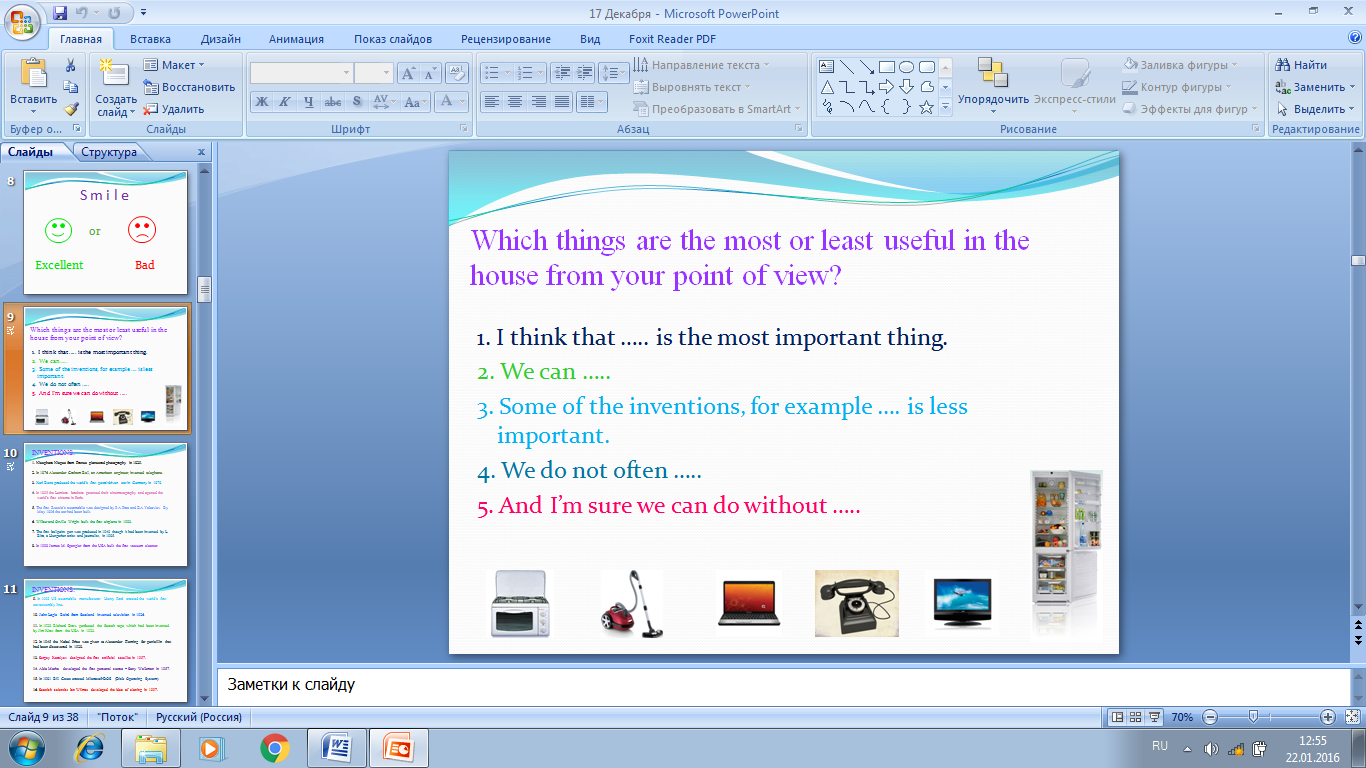
Worksheet №3
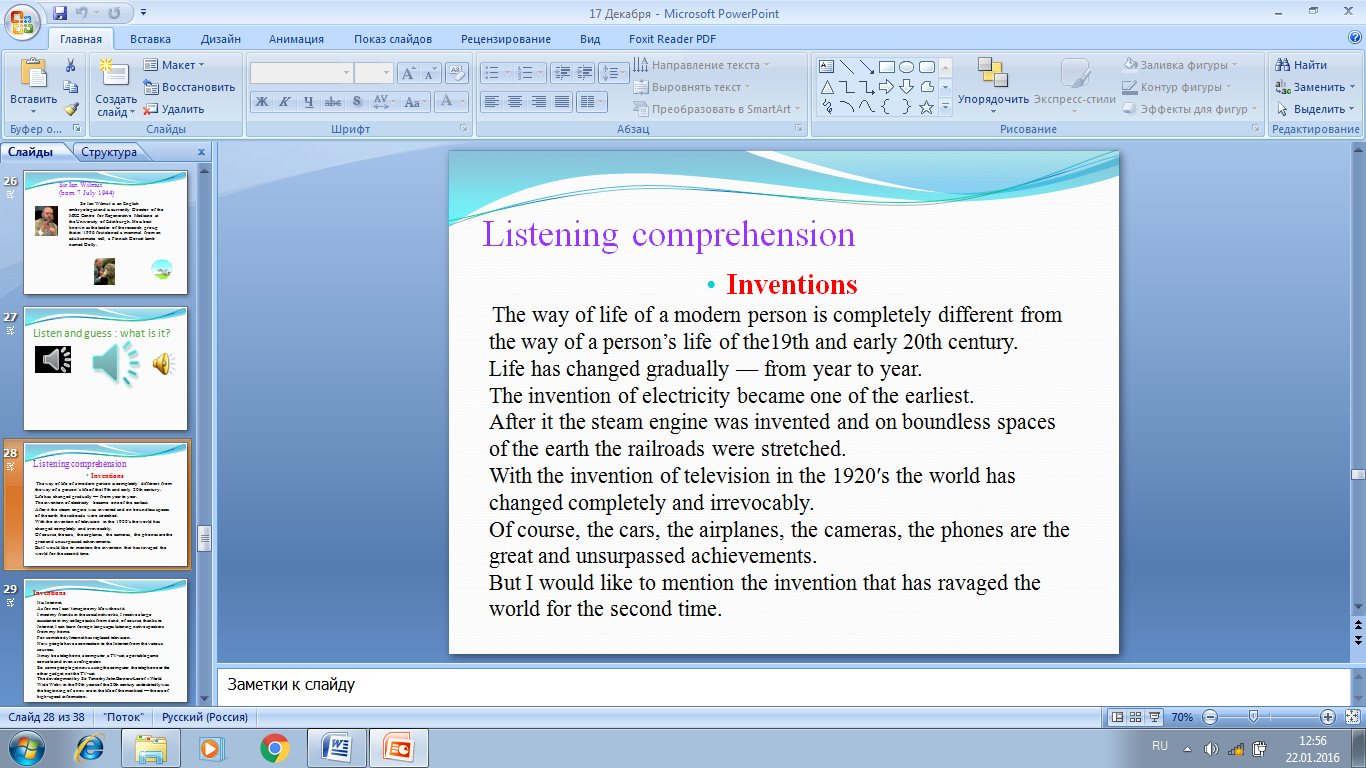
T: Time is up.
Change your sheets of paper. Let’s check up the spelling of the words. Put the marks to each other.
T: Look at the screen! (Слайд 7)
If you have got 2 mistakes, your mark is V. Good
4 mistakes – Good
6 mistakes – Sat
More than 6 mistakes – Unsat, unfortunately.
T: Students, don’t forget to put your mark at the end of our English lesson.
You will choose the smile:
Excellent or Bad.
T: 1 minute is up. Self-check.
4. T: It’s interesting for me what of the modern inventions do you have at home? (обучающиеся отвечают, перечисляя бытовую технику, которая есть дома, используя лексику прошлых уроков.) ( Слайд 8)
S1. I have a TV set and a DVD player.
S2. I have a computer and a calculator, an alarm-clock.
S3. I have a vacuum cleaner and a microwave oven.
S4. I have a mobile phone and a camera.
S5. I have a washing mashine and a car. (Слайд 9)
T: Thank you, stop please.
4 a) T: Now answer my questions, please.
1. What units and machines do you use in your household?
2. What do you use for washing the dishes?
3. What do you use for calling somebody who is far from you?
4. What do you use for cleaning rooms?
5. What gadget do you use for taking photos?
6. What do you use for listening to music?
7. What do you use for doing calculations?
8. What do you use for waking up?
S1: I use many of them: a car, a computer, a refrigerator, a vacuum cleaner and so on.
T: I see. What is the most useful thing for your mother?
S2: In my opinion, it is a cooker.
T: What unit or machine can’t you do without?
S3: It is my computer.
T: What thing can’t your father live without?
S4: Without TV, to my mind.
T: What thing do you use every day?
S5: I think, it is my mobile telephone.
T: What thing can you easily do without?
S6: It is a sewing machine. I hardly ever use it.
T: What is the most useless thing in your household?
S7: It is a video recorder. I am always lack of time to use it.
T: What thing do you use regularly?
S8: I can’t live without my mobile telephone.
T: What is your favourite unit?
S9: I think it is my walkman. I am fond of listening to music.
T: What about you?
S10: I like watching TV.
T: I see. Well, you use many units and machines. Thank you.
b) Speaking
T: Dear friends, do the task working in your each group.
Gr. №1 – You’ll speak about TV.
Gr. №2 – And you’ll speak about a computer.
Students do the task working in small groups, then they share their ideas with the whole class.
4 c) Now, let’s practice in reading and translating.(Слайды 10-27)
S1: Joseph Nicéphore Niépce from France pioneered photography in 1829.
S2: Жозеф Нисефор Ньепс из Франции изобрёл способ фотографирования в 1829.
S1: In 1876 Alexander Graham Bell, an American engineer, invented telephone.
S2: В 1876 году американский инженер Александр Бэл изобрел телефон.
S1: Karl Benz produced the world’s first petrol-driven car in Germany in 1878.
S2: В 1878 в Германии Карл Бенц произвёл первый в мире автомобиль, работающий на бензине.
S1: In 1895 the Lumiere brothers patented their cinematography and opened the world’s first cinema in Paris.
S2: В 1895 братья Люмьер запатентовали кинематограф и открыли первый в мире кинотеатр в Париже.
S1: The first Russia’s automobile was designed by P.A.Frez and E.A.Yakovlev. By May 1896 the car had been built.
S2: Первый автомобиль в России был построен П.А.Фрезом и Е.А.Яковлевым. К маю 1896 года машина была построена.
S1: Wilbur and Orville Wright built the first airplane in 1903 (USA).
S2: В 1903 в США братья Райты построили первый аэроплан.
S1: The first ballpoint pen was produced in 1940 though it had been invented by L. Biro, a Hungarian artist and journalist, in 1905.
S2: Первая шариковая ручка была изготовлена в 1940 году, хотя она была изобретена Л.Биро, венгерским художником и журналистом, в 1905 году.
S1: In 1908 James M. Spangler from the USA built the first vacuum cleaner.
S2: В 1908 Джемс Спенглер из США построил первый пылесос.
S1: In 1908 US automobile manufacturer Henry Ford created the world’s first car assembly line.
S2: В 1908 американский фабрикант Генри Форд создал первый в мире автомобильный сборочный конвейер.
S1: John Logie Baird from Scotland invented television in 1926.
S2: Джон Бард из Шотландии изобрёл телевидение в 1926.
S1: In 1928 Richard Drew perfected the Scotch tape, which had been invented by Jim Kirst from the USA in 1923.
S2: В 1928 году Ричард Дрю улучшил шотландскую плёнку (скотч), которую изобрёл Джим Кист из США в 1923 году.
S1: In 1945 the Nobel Prize was given to Alexander Fleming for penicillin that had been discovered in 1928.
S2: В 1945 году Нобелевскую премию вручили Александру Флемингу за пенициллин, который был открыт в 1928 году.
S1: Sergey Korolyev (Russia) designed the first artificial satellite in 1957.
S2: Сергей Королёв (Россия) разработал первый искусственный спутник в 1957.
S1: Akio Morita (Japan) developed the first personal stereo – Sony Walkman in 1957.
S2: Акио Морите (Япония) разработал первую персональную стереосистему Sony Walkman в 1957 году.
S1: In 1981 Bill Gates (USA) created Microsoft-DOS (Disk Operating System).
S2: В 1981 Билл Гейтса (США) создал Microsoft-DOS (Дисковую Операционную Систему).
S1: Scottish scientist Ian Wilmat developed the idea of cloning in 1997.
S2: Шотландский ученый Ян Вилмат разработал идею клонирования в 1997.
Listening comprehension (с опорой) (Слайды 28-30)
T: Bill Gates is an American who created Microsoft Disk Operating System in 1980. Operating system in 1980. This system is know all over the world now.
T: According to our plan now, let us read and to the text simultaneously. Dier friends, this information is about one of the remarkable invention made by man.
Your task: 1) Guess what is it?
2) After reading and listening to the text you have to do one more task: to fill in the gaps with the proper words.
Listening – 2:08
T: Well, your answer please. What is it?
Did you guess about one of the remarkable invention made by man?
Students: “It’s an Internet”.
T: Thank you! You are right! Now TAKE THE PINK SHEETS OF PAPER, fill in gaps with the proper words. You have got only 3 minutes.
T: Time is up. Finish, please. Check yourself.
T: Students! Look at the screen! And check your answers.
Electricity
The steam engine
Internet
A connection
Sir Timothy John Berners – Lee
T: I’d like you to look thrue your vocabulary and grammar rules in your copy-books and do tasks.
Let’s work in pairs! Scan the words, grammar rules in pairs and do tasks.
(Раздаются карточки с заданиями)
Card 1.
Card 2.
Card 3.
Card 4.
Card 5.
T: I give you 8 minutes. Let’s start.
(Выполняется дифференцированная работа в парах)
T: Finish! Give me your worksheets and I’ll check them myself.
(В это время пока учитель проверяет карточки с выполненными заданиями, студенты слушают песню и просматривают видеоролик)
T: Students, look at the screen, listen to a song “Inventions and inventors” and be ready to answer the question: Do you know who invented all these things? Let’s listen to a song and find it out. (Слайд 32)
T: NOW TAKE THE BLUE SHEETS OF PAPER.
Try to match the names of inventors and their inventions. You have got only 1 minute.
(Студенты соотносят изобретения и изобретателей)
T: Finish. Self-check. Thank you. You are right.
Ролевая игра “Meeting a famous inventor” (Слайд 33)
-Hello, I'm Alexander Graham Bell. I'm glad to see you here and I hope you are happy to use one of my inventions. What is it?
Group: It's a telephone
Teacher: You have an opportunity to ask all your questions now.
G: Where did you study?
- At the university of Edinburgh
G: What was your favorite subject?
-My favorite subjects were sciences, especially biology.
G: Was it difficult to invent a telephone?
- Yes, it was. It took me a lot of time.
G: Did anybody help you?
- Yes. my assistant Watson helped me.
G: I've heard that you were not only an inventor. What else did you do?
- I was a teacher at the university
G: What university did you teach in?
- Boston University
G: What should we do to be successful?
-I shall read you 10 steps to success:
Try.
Try again.
Try once more.
Try it a little differently.
Try it again tomorrow.
Try and ask for help.
Try to find someone who's done.
Try to determine what is not working.
Try to determine what is working.
Just keep trying.
-Good luck to you
Беседа о российских изобретателях. (Слайды 34-36)
T: These were English and American inventors.
7 a) Монологическое высказывание
T: Your self-preparation task was to preparation task was to prepare some information about Russian inventors.
Now you can tell us about them.
7 b) Диалогическая речь (Обсуждение прослушанных сообщений).
T: Thank you, dear friends. Your information was very usefull and interesting. Students, you may ask 4 questions to each group and discuss reports about Russian inventors.
G r.1 Gr.2
r.1 Gr.2
 Gr.2 Gr.1
Gr.2 Gr.1
T: I give you 6 minutes.
Conclusion. (5 min.)
Подведение итогов, рефлексия. (Слайды 37-38)
T: Today we have learned some facts about famous inventors (we can call them Great Minds) and their inventions. Was it interesting for you? I'm sure you have understood our topic of the lesson because you have read, understood and you have spoken.
Your home task: You will make a project about one of the Great Minds. (Объяснения задания на самоподготовку) Find some more names of great minds and their inventions in Russia and in other countries, according to the chosen field of science.
T: I’d like to thank you for your work. You were really great! I hope you’ve learned much and perhaps will use your knowledge of English in the future. Your marks are …
Well, I think our time is up. Thank you for your work and attention.
Worksheet №1
Fill in the missing letter in the words:
DVD pla…er, comp…ter, calc..l..tor, al..m, clo..k, vac..ume cle..ner,mi..row..ve ov..n, mob..le p..one, c..mera, was..ing mach..ne, co..ker, wa..hing dish..s, frid..e, pl..ne,gad..et, TV s..t, sc..ent..st.
Worksheet №2

Worksheet №3

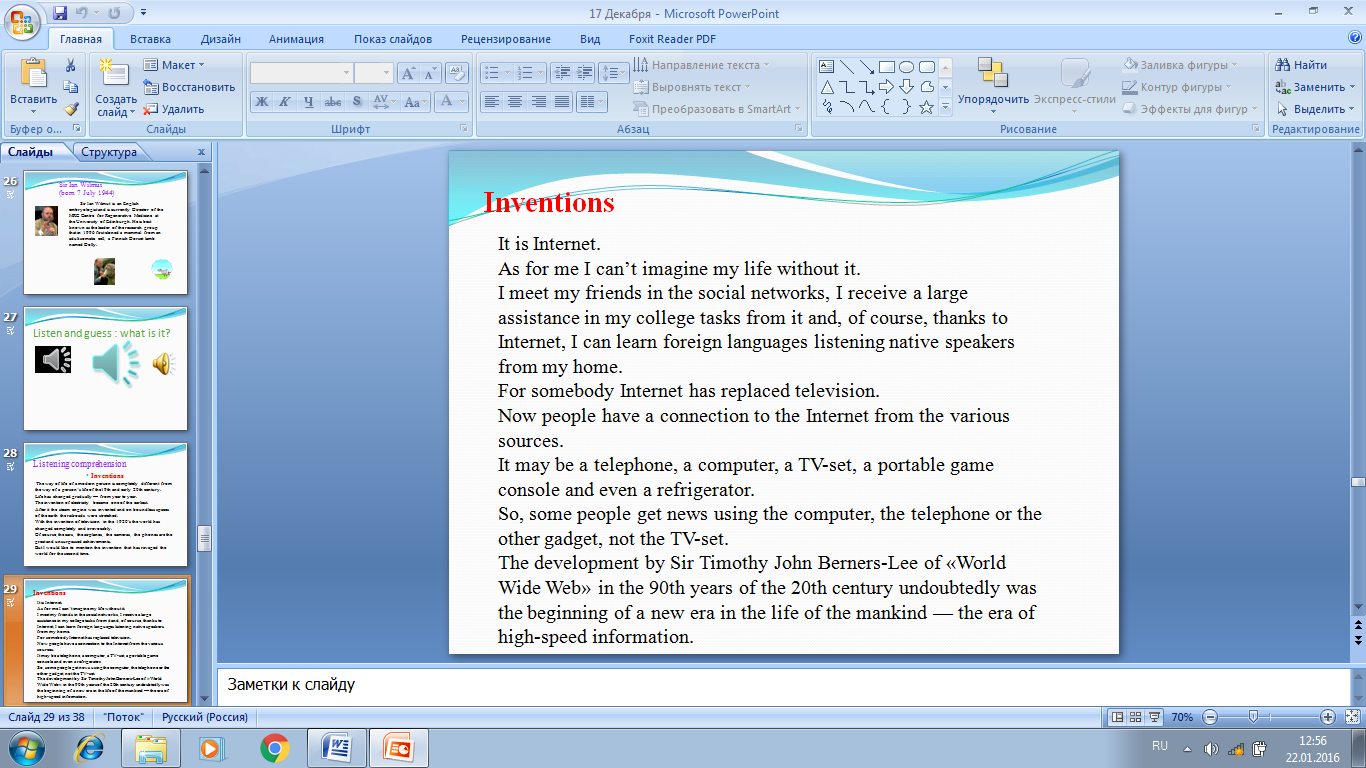

Worksheet №4
Match the inventors and their inventions.
| Bell | Telephone Phonograph Automobile Television Plane Electric light bulb projector |
| Benz |
| Baird |
| Edison |
| Wright brothers |
Worksheet №5
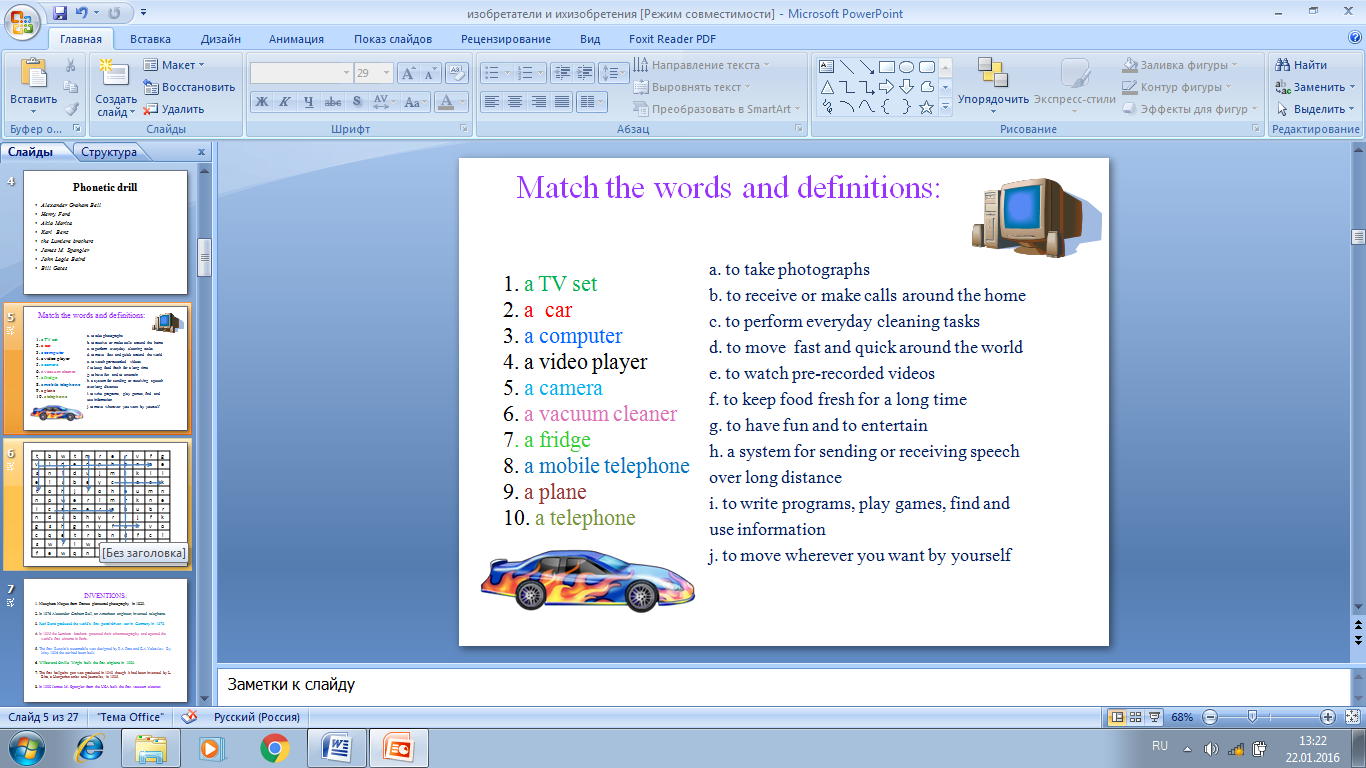
Worksheet №6 A
Read the text. Put the verbs in brackets into their Past form. Guess, who is the text about?
M ost people know that he (create)1 the first working light bulb,
ost people know that he (create)1 the first working light bulb,
b
 ut they don’t know anything else about him. He (invent) 2 over 1000 different things. Among his inventions are: the phonograph (record player), the movie camera and the movie projector. He (make) 3 his electric light bulb in 1879, but there was still much work to do. No one (know) 4
ut they don’t know anything else about him. He (invent) 2 over 1000 different things. Among his inventions are: the phonograph (record player), the movie camera and the movie projector. He (make) 3 his electric light bulb in 1879, but there was still much work to do. No one (know) 4



 how to use electricity outside of laboratory. He and his workers created a safe electric system. First they (build)5 a factory. Then they (have)6 to build the dynamos to make the electricity. Next they had to build electric lines. To show people that he (be)7
how to use electricity outside of laboratory. He and his workers created a safe electric system. First they (build)5 a factory. Then they (have)6 to build the dynamos to make the electricity. Next they had to build electric lines. To show people that he (be)7
s erious, he (begin)8 his project in New York City. By 1887, most part of New York City was electrified.
erious, he (begin)8 his project in New York City. By 1887, most part of New York City was electrified.
H
 e (live)9 until 1931. He (continue)10 to invent all his life. He was a true genius.
e (live)9 until 1931. He (continue)10 to invent all his life. He was a true genius.
Worksheet №6 B
Read the text. Put the verbs in brackets into their Past form. Guess, who is the text about?
He was born in Edinburgh, Scotland, in 1847.His father (be) 1________ a world-
famous inventor of « Visible Speech » ,which (help) 2____________deaf people to pronounce words they could not hear. Between 1868 and 1870 he (work)3 ________with his father and (study)4____________speech and (teach)5_______thinking about sending tones by telegraph ,and it was then that there (come)7___________to his mind the idea of the “harmonic telegraph”, which would send musical tones electrically from one place to another. He (become)8_________interested in the mechanical production of a sound. In this way, sound (can)9______be carried across wires at the speed of light. In 1876 he was able to develop the telephone, which enables people to talk to each other over long distances. In 1915 the first transcontinental telephone was opened. He (die)10__________ on August 2, 1922.
Worksheet №7
Rewrite these sentences in Passive Voice
Henry Ford invented the assembly line in 1903
__________________________________________________________
Alexander Bell invented the telephone in 1876
__________________________________________________________
John Logie Baird invented colour television in 1928
__________________________________________________________
Alexander Fleming invented penicillin in 1928
__________________________________________________________
Igor Sikorsky invented a helicopter in 1909
__________________________________________________________
Sergei Korolyov invented a satellite Sputnik 1 in 1957
__________________________________________________________
John Walker invented matches in 1827
___________________________________________________________
Worksheet № 8
To gather stickers with words and make up sentences
1)-Edison invented an electric light bulb.
2)- A helicopter was invented by Sikorsky.
3)-Korolyov invented the first satellite.
4) -A telephone was invented by A.Bell.
Worksheet №9
Match the names of inventors ahd their inventions.
O rville and Wilbur a plane
rville and Wilbur a plane
E dison a phonograph and projector
dison a phonograph and projector
B enz the automobile
enz the automobile
B arid a TV
arid a TV
F ulton a stemboad
ulton a stemboad
F ord the assembly line for cars
ord the assembly line for cars
Worksheet № 10
Ask questions
-Where / born?
-Where / study?
-What / most important invention?
- When / invent it?
\
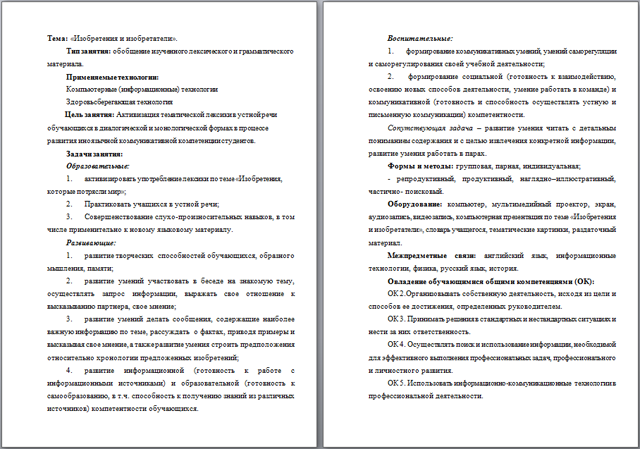

 Получите свидетельство
Получите свидетельство Вход
Вход





 r.1 Gr.2
r.1 Gr.2 Gr.2 Gr.1
Gr.2 Gr.1


 ost people know that he (create)1 the first working light bulb,
ost people know that he (create)1 the first working light bulb, 
 ut they don’t know anything else about him. He (invent) 2 over 1000 different things. Among his inventions are: the phonograph (record player), the movie camera and the movie projector. He (make) 3 his electric light bulb in 1879, but there was still much work to do. No one (know) 4
ut they don’t know anything else about him. He (invent) 2 over 1000 different things. Among his inventions are: the phonograph (record player), the movie camera and the movie projector. He (make) 3 his electric light bulb in 1879, but there was still much work to do. No one (know) 4 

 how to use electricity outside of laboratory. He and his workers created a safe electric system. First they (build)5 a factory. Then they (have)6 to build the dynamos to make the electricity. Next they had to build electric lines. To show people that he (be)7
how to use electricity outside of laboratory. He and his workers created a safe electric system. First they (build)5 a factory. Then they (have)6 to build the dynamos to make the electricity. Next they had to build electric lines. To show people that he (be)7  erious, he (begin)8 his project in New York City. By 1887, most part of New York City was electrified.
erious, he (begin)8 his project in New York City. By 1887, most part of New York City was electrified. e (live)9 until 1931. He (continue)10 to invent all his life. He was a true genius.
e (live)9 until 1931. He (continue)10 to invent all his life. He was a true genius. dison a phonograph and projector
dison a phonograph and projector enz the automobile
enz the automobile arid a TV
arid a TV ord the assembly line for cars
ord the assembly line for cars








 Методическая разработка урока по английскому языку «Изобретения и изобретатели» (2.12 MB)
Методическая разработка урока по английскому языку «Изобретения и изобретатели» (2.12 MB)
 0
0 1342
1342 167
167 Нравится
0
Нравится
0


